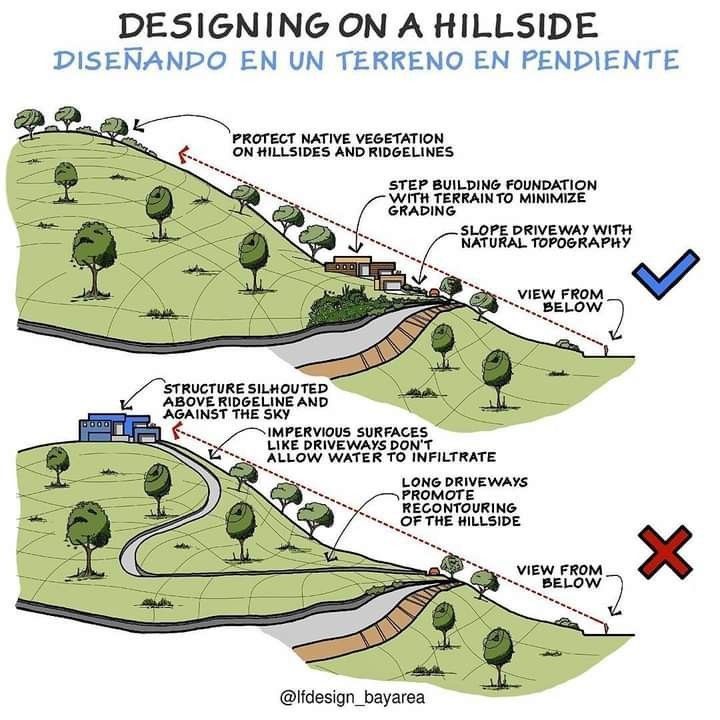Smart hillside architecture protects landscapes, reduces erosion, and creates homes that harmonize with their environment.
🌄 Hillside Living: A Dream With Challenges
Across the world, people are drawn to hillside properties. Elevated homes provide breathtaking views, fresh breezes, and a connection to nature that flatland homes rarely match. But with these advantages come serious architectural and environmental challenges.
Building on a slope requires more than just pouring concrete and raising walls — it requires sensitivity to the land. Poorly designed hillside homes can scar the landscape, disrupt drainage, and stand out like eyesores against the skyline.
The diagram above makes the contrast crystal clear: the right way (✔️) respects the slope and natural vegetation, while the wrong way (❌) forces the land to change unnaturally, leading to both visual and environmental problems.
✅ The Right Way: Building With the Slope
In the upper example, the home is carefully tucked into the terrain rather than imposed upon it.
Key Elements of Good Hillside Design:
- Protect Native Vegetation 🌳
Instead of clearing all trees and plants, vegetation is preserved along the slope and ridgelines. This prevents soil erosion, maintains biodiversity, and keeps the hillside visually appealing. - Stepped Foundation 🏠
The home’s foundation follows the slope with a stepped design. This minimizes excavation and grading, meaning the natural topography is disturbed as little as possible. - Driveway Sloped With the Land 🚗
The driveway flows with the hill’s natural slope rather than cutting harshly into it. This reduces runoff and erosion while blending the design with the land. - View From Below 👀
When viewed from below, the home feels integrated into the hillside rather than standing harshly against the skyline. It blends with nature instead of dominating it.
This design philosophy creates homes that work with the land, not against it. The result is sustainability, beauty, and harmony.
❌ The Wrong Way: Forcing the Land to Change
In the bottom example, the home is an example of poor hillside planning.
Key Mistakes in Bad Hillside Design:
- Silhouetted Against the Sky 🌌
The structure is placed directly on the ridgeline, making it stand out unnaturally. Instead of blending with the environment, it becomes a stark silhouette against the sky. - Impervious Surfaces 💧
Large, flat driveways are added, preventing rainwater from naturally soaking into the soil. Instead, water runs off, leading to erosion and flooding downstream. - Excessive Recontouring ⛏️
Long, winding driveways cut deep into the hillside. This destroys the natural contour of the land, removes vegetation, and weakens slope stability. - Unattractive From Below 👎
From a lower vantage point, the home looks bulky and disconnected, dominating the hillside rather than respecting it.
This design approach is not only aesthetic pollution, but it also creates long-term environmental risks such as landslides, soil loss, and increased flooding.
🌍 Why Hillside Design Matters
Hillsides are delicate ecosystems. Altering them carelessly can cause chain reactions that affect entire communities.
- Soil Erosion → Removing vegetation loosens soil, which can wash downhill during heavy rains.
- Flooding → Impervious driveways and flat pads change natural drainage, creating water surges.
- Landslides → Cutting into slopes without stability planning increases collapse risk.
- Loss of Biodiversity → Clearing trees destroys habitats for birds, insects, and wildlife.
- Visual Impact → Homes that stand out on ridgelines disrupt the natural beauty of landscapes.
By contrast, homes that work with topography prevent these issues, creating lasting harmony between humans and nature.
🛠️ Principles of Smart Hillside Design
From architects and engineers specializing in sloped terrain, a few golden rules emerge:
- Follow the Contours → Build along the slope, not against it. Step foundations instead of leveling large pads.
- Preserve Vegetation → Keep as many trees and plants as possible for slope stability and natural beauty.
- Blend Rooflines → Use smaller roof components that match the hillside rather than massive, flat shapes.
- Minimize Impervious Surfaces → Opt for permeable driveways or stone pavers that allow rainwater infiltration.
- Avoid Ridgelines → Place buildings slightly below the ridge to keep them visually discreet.
- Respect Drainage Paths → Don’t block natural watercourses; integrate them into the design.
🌱 The Human Side: Comfort and Livability
Good hillside design doesn’t just protect nature — it improves human living:
- Better Climate → Homes integrated into slopes stay cooler in hot weather and warmer in cold weather.
- Peace and Privacy → Natural vegetation and slope contours create secluded outdoor spaces.
- Safer Living → Reduced erosion and landslide risks mean homes are structurally secure.
- Visual Harmony → Residents enjoy landscapes that look natural, not carved apart.
When done right, hillside homes become sanctuaries — places where people live in comfort without disturbing the environment around them.
📈 Future of Hillside Architecture
With urban expansion and climate change, hillside design will become even more important. Cities are spreading into mountainous and sloped regions, where mistakes could be disastrous. Future trends include:
- Green Roofs and Walls → To camouflage buildings into slopes.
- Rainwater Harvesting → Integrated into hillside drainage systems.
- Terraced Living → Breaking slopes into usable levels while preserving natural flow.
- Sustainable Driveways → Using gravel or porous materials to absorb rainfall.
The future is clear: hillside architecture must be sustainable, discreet, and resilient.
✨ Conclusion: Build With Respect
The image shows a simple truth: the hillside is not just a foundation — it’s a living system.
- The ❌ way disrespects the land, cutting and reshaping it until it becomes unstable and unsightly.
- The ✔️ way respects the slope, vegetation, and drainage, allowing the home to feel like a natural extension of the hillside.
For homeowners, architects, and planners, the message is powerful: build with nature, not against it. Doing so ensures not only beautiful, comfortable homes but also landscapes that remain stable and thriving for generations.
